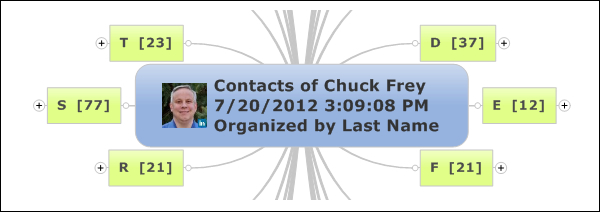What if you could export your Linkedin connections to a mind map? A new software program called IM-LKDIN now makes that possible. When I first heard of it in a Linkedin MindManager group, I was really excited by this idea. But what I discovered is a program that is still a bit rough around the edges.
IM-LKDIN is not a MindManager add-in. Rather, it’s a stand-alone software program that links to your Linkedin account, parses your connection data and passes it to MindManager, where the mind mapping program creates 4 types of maps, with contacts grouped by last name, country and region, industry and company name. It can create each of these maps in two versions:
Light – which contains only basic data about your Linkedin contacts
Full – contains detailed data about each person in tables that are attached to each person’s name.
IM-LKDIN gives you the option of deciding how many of these 8 mind maps you want it to produce. You can also exclude companies that only have one employee. You also need to tell the program your Linkedin login, and authorize Linkedin to communicate with it.
IM-LKDIN downloads your Linkedin data in an XML format, which it parses into a format that MindManager can read, and then outputs it in .MMAP files that are readable by the mind mapping program. When IM-LKDIN is done producing the mind maps you requested, it displays a screen like the one below that displays the file names it created and buttons to open each one. The file names are long and complex, but if you look at them closely, you can figure out which map is which.
When I looked at the mind maps that IM-LKDIN created from my Linkedin data, MindManager 12 encountered several XML errors. So I was only able to open about half of the maps it produced.
My impression of IM-LKDIN
In concept, the idea of connecting your Linkedin data with a mind map sounds incredibly cool. But in practice, I found it to be not as useful as I had expected. Here’s why:
The mind map sorted by last name contains too many branches and levels. For example, in the screen capture at right, the letter “S” contains 77 people. Opening up that branch causes a huge amount of data to be displayed.
The mind map sorted by company name also generated a large number of branches. In an attempt to keep these large data sets manageable, the developer made the second level of each map a letter of the alphabet. So, for example, if I wanted to look at my contacts at the global equipment manufacturer Caterpillar, I would first need to open the Caterpillar branch. If one of my contacts was Bob Smith, I would next need to click on the child topic named “B,” which would open a third level set of topics that would be everyone I know at the company whose last names start with “B.”Unless you have a gigantic number of contacts at one company, I don’t think this extra level is necessary. In my opinion, it made the maps harder to navigate.
How would I improve IM-LKDIN?
First, let me start out by saying that all of my recommendations are based upon how much reorganizing I would need to do to transform IM-LKDIN’s output into a usable format. In other words, if I want my Linkedin data in a mind map, it’s because I don’t just want look at it in a visual format, I want to actually DO something with it – like manage a job search, for example. Right now, the maps generated by IM-LKDIN would need a lot of tweaking and cleaning up to be useful to me.
It would be nice if the application adopted more of a “wizard” approach to pulling Linkedin data into mind maps. For example, I may not want to have every single connection imported. It would be great if the application could first get the necessary credentials from Linkedin, and then take you through a series of steps to filter or reduce the number of contacts down to a usable number based on several criteria. I’m not sure what those criteria should be, but this approach would result in smaller, more manageable and more useful mind maps.
Anything beyond a person’s name and company should be placed within topic notes, to minimize visual clutter. I ought to be able to get a high-level view of my contacts without having to wade through a ton of data.
As I indicated earlier, the alphbetical topics can be eliminated in some of the maps, where they simply don’t add any value but just force you to click down another level in order to reach the information you need.
Conclusion
I must temper my opinions with the fact that this is a version 1.0 application, which is bound to have a few bugs and some unfinished or a less polished user interface. I hope the developer continues to improve IM-LKDIN and that it evolves into an excellent tool for making productive use of your Linkedin data.


Leave a Reply